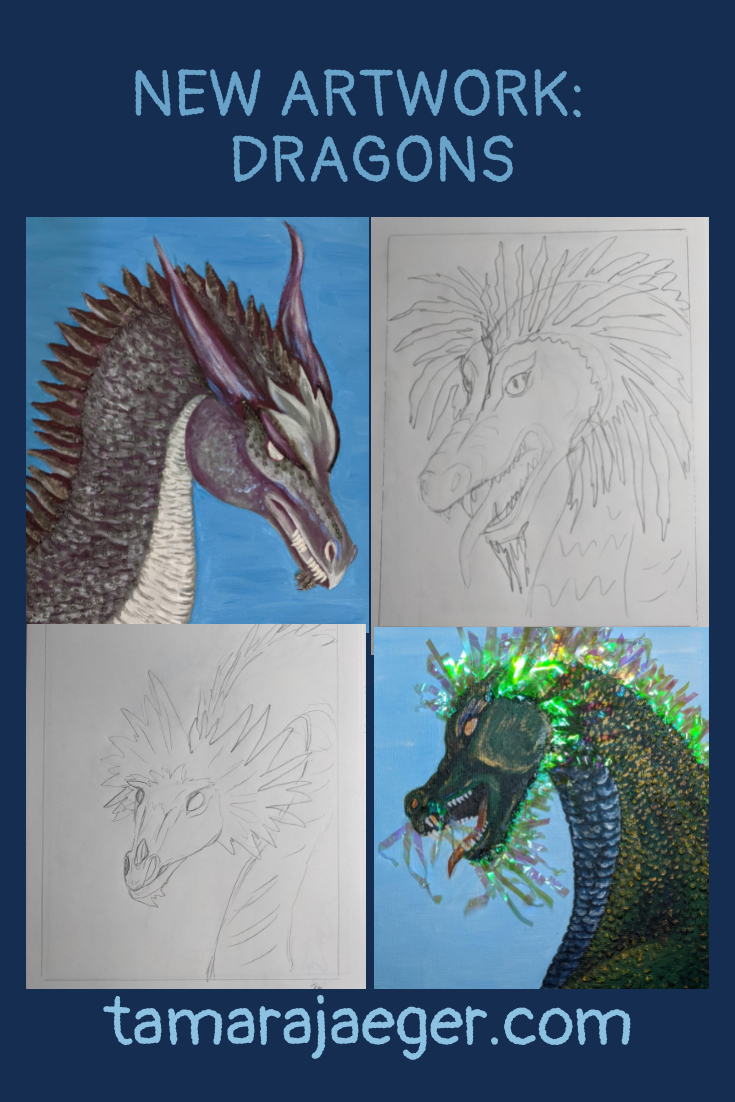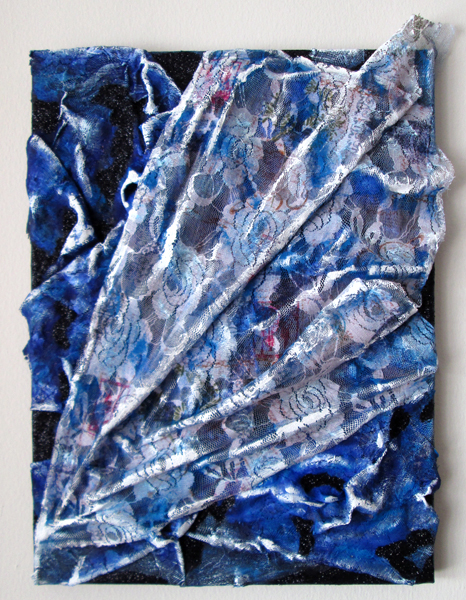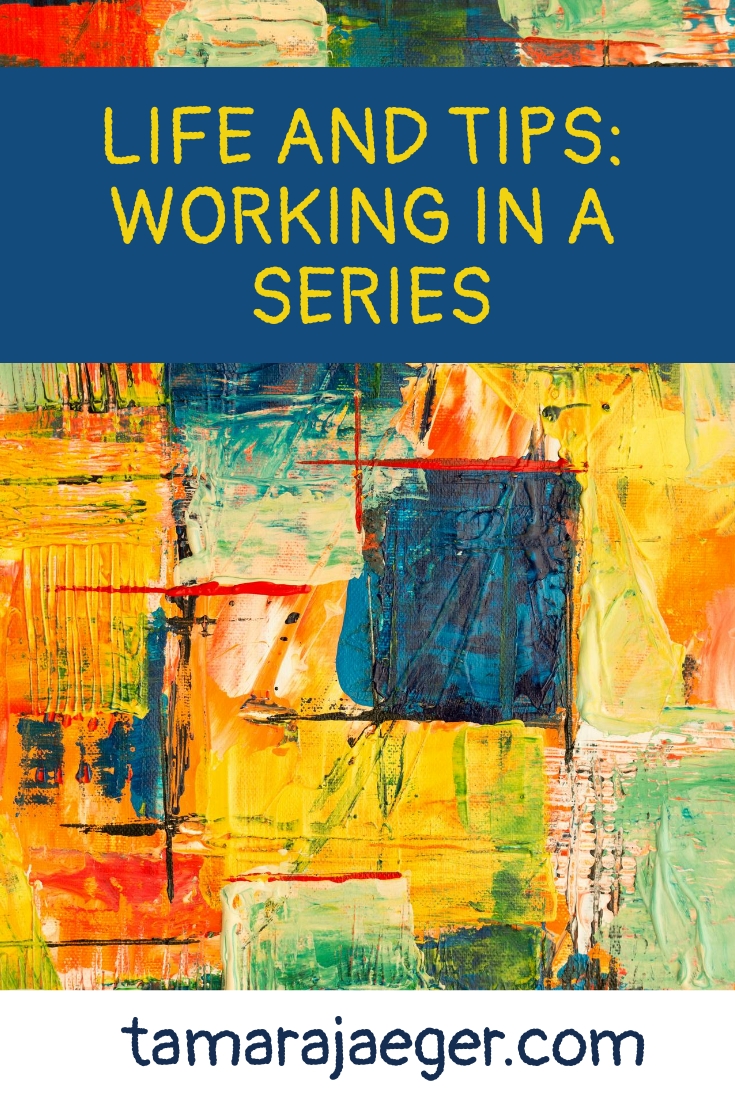Posts Tagged: water


New Artwork: “Dragons” Mixed Media Series
I’ve been working on a new series of mixed media acrylic paintings, which I call the “Dragons” series. In my sketchbook, I had this noted as a completely abstract series. Sometimes things evolve a bit from the initial concept though!

I have a lot of just notes and quick, rough sketches in my sketchbook, rather than “good” art. I’m not all that fond of sketching and drawing, really. Perhaps I’ll do a post about my sketchbook sometime, so you can see my thought process. Just remember, there’s no ‘wrong way’ to use a sketchbook! If it works for you, that’s all that matters.
I currently have 8 dragons planned. They’re all 8” x 10” portrait-orientation pieces on canvas that combine acrylic painting with various other materials. I’m about 2/3 of the way through the series, though it’s slow going at times for some reason. None of the pieces is completely finished either. I haven’t quite figured out what to do with the eyes…
So, I suppose this is more of a sneak peek, work-in-progress post. I’ll have to update you when again they’re actually finished.
But I’m not about to leave you hanging! Here are some of the Dragons:
This is the Water Dragon.

He uses some of that shredded plastic stuff that people use in gift bags. I think some of it is also Easter grass, from Easter baskets. I’m not entirely sure… I found it on the ground in the neighborhood. I was ‘inspired’ by my Inspired Art piece that I told you about here, so I’ve been continuing to collect some of the interesting trash I find on my walks. I also used glass seed beads for texture. I quite like the look, so I’m planning on incorporating beads into all the Dragons.
Another Dragon I’ve been working on is the Shadow Dragon.

He uses pieces of purple ribbon and a grey velvet fabric that used to be part of a hair scrunchie.
Here is the Song Dragon.

I used sheet music that I printed out and then tore into pieces, much like my torn paper collages. I used Golden Acrylic Soft Gel Medium as an adhesive. There are also pieces of reflective/metallic plastic strips (more of that shredded gift bag stuff, I think).
Forest Dragon is a little different.

He uses pieces of lichen-covered bark and some dried mushroom stuff that is supposed to be ‘vase filler.’ I think it works much better here! The horns are actually three-dimensional, made with Golden Light Molding Paste, which I also used to build up a base to hold the mushroom piece, so it’s firmly attached and well-supported.
The Fire Dragon and Ice Dragon are in the very early stages, so I’m not going to show them just yet. I call it the “Ugly Duckling” stage for a reason! I haven’t really started on the Wind Dragon or the Lightning Dragon. They’re sketched out onto canvas, awaiting my attention…
I’m considering still doing a fully abstract dragon series. There’s no reason I can’t have more than one, right?
Want to stay up to date and see more of what I’m working on? Sign up for my mailing list here and get a FREE digital download of an exclusive tiger linocut print. (I promise not to be spammy with my emails—I hate that too!)
* Please note that this post contains affiliate links and any sales made through such links will reward me a small commission – at no extra cost for you.


Artwork Series: Elementals
Earlier this week I talked a bit about creating art in a series. I’d like to talk a bit more today about one of the series that I mentioned in that post—my “Elementals” series.

I created the “Elementals” with the intention of exploring color and texture within the framework of the four (western) elements: fire, water, air, and earth. I decided there would be three pieces for each element, each piece would be on the same size canvas, and the pieces for an element would use the same color palette. I also wanted to title each piece with the name of a mythological creature. The exact title was generally chosen after the piece was completed since the exact form of each wasn’t specified in advance—the processes I used to create the pieces weren’t really conducive to pre-defined layouts of shape and color.

I started with the fire pieces: Dragon, Phoenix, and Firebird. These were done in red, oranges, and yellows and as you can see, the textures and designs are quite varied. The water pieces—Hydra, Kelpie, and Kraken—were done in blue-green tones while the air pieces—Pixie, Griffin, and Harpy—were done in blues and whites. The earth pieces—Golem, Satyr, and The Green Man—were done in browns and greens. I also tried to bring in texture that suited the element when possible—feathers for Griffin or the lacy, airy fabric for Harpy, for example, or the rough, earthy burlap of Satyr and the moss and pinecones in The Green Man.

This series was about exploring how I viewed the colors and textures I associated with the four elements, my feelings behind them, rather than attempting to create predefined physical representation of the elements.

Tell me about a series you’ve worked on or have planned. I’d love to hear about it!


Life and Tips: Working in a Series
When I was in college, one of my art professors suggested that it would be good to start working on pieces that were in a series. Before that point I, like most art students, was focused on individual projects and pieces, with no attempt at creating an over-arching theme or connection between pieces. Now partly this is simply due to being a student. You take classes and your professors dictate what you should be working on to a large extent. And that’s fine, up to a certain level. But eventually you reach the point where you need to take your art further than just developing proficiency in a technique or medium. That is when working in a series comes in.
Why work in a series?
One of the main benefits to working in a series is that it gives you a chance to fully explore a subject, thinking about it deeply and fully. With a deeper understanding of your subject, you can express it on a deeper, more meaningful and insightful level than if you just create one or two pieces. For the viewer, a series provides a cumulative effect– multiple related pieces craft a deeper understanding of the artist and their work. Working in a series also creates a cohesive body of work that can, for example, be used for showing in galleries or exhibitions.
How to create a series
When working in a series, the first step is to choose your subject. Now, I’m using “subject” loosely—it doesn’t have to be a specific item or physical object, though it certainly can be. There’s absolutely no reason your subject can’t be flowers or old barns or cats or whatever else you want! But your subject can also be more abstract. It can be a technique or pattern or color. It can be a certain texture or design or even an emotion that you are exploring. Basically, your subject is the overall unifying theme for the pieces in your series.




As an example, I created my “Elementals” series to explore the four elements of fire, water, air, and earth. I also have a series—“Below the Surface”—that was inspired by a trip to a rock and mineral show. The subject for that series was geological features.
Once you’ve chosen your subject, the next step is to define what your series will consist of. Brainstorm your possibilities. I find it helpful to do a series of quick sketches to lay out my ideas. These are mostly just rough, gestural sketches—not detailed, specific images—which help me to visualize the series and the connections between the pieces. Detailed sketches can come later, when you’re ready to start creating. Set your series specifications. How many pieces will be in the series? What size or sizes will they be? Consider your sketches and ideas with the focus of seeing how these pieces will form a cohesive set.

For my “Elementals” series, I knew that I wanted to have three pieces for each element and all the pieces were going to be on the same size canvas. I wanted to explore color and texture, and having the same canvas size helped to create a sense of unity for the pieces. “Below the Surface” was a little different. Each piece was wildly different in size, shape, color and texture. The unifying feature here is primarily the subject itself. This is also a series where I had many more ideas than made it into reality. Of course, there’s no reason I can’t go back and add to the series. All it takes is a trip back through my sketchbook to remind myself of the ideas and then set myself to bringing them to life.

Now that you’ve got your theme and know what pieces will be in your series, it’s time to get to work and make art!
What about you? Do you work in series? If not, why? If so, what things do you consider when developing your series? Tell me in the comments!